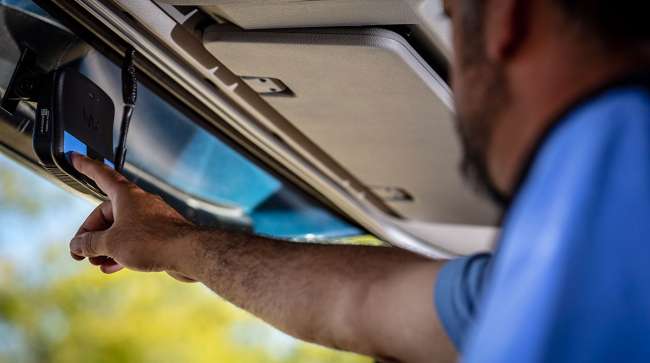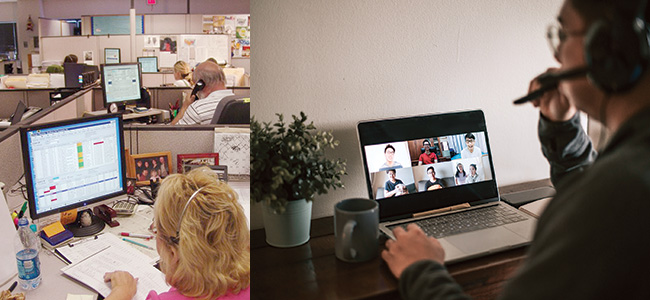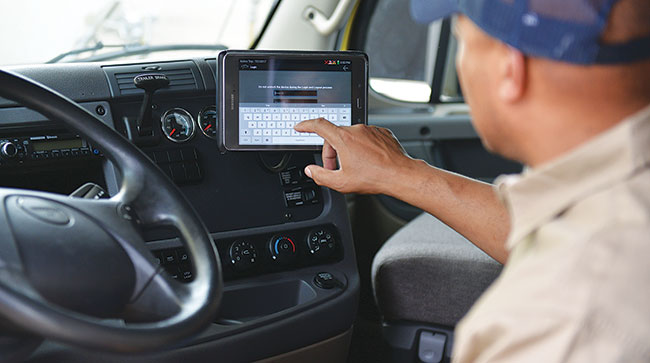Fleets Push Forward With Tech Investment Despite Pandemic, Economic Uncertainty

[Ensure you have all the info you need in these unprecedented times. Subscribe now.]
Despite facing business challenges and economic uncertainty, some trucking companies have continued to move forward with technology investments during the COVID-19 outbreak.
While the coronavirus pandemic has taken a heavy financial toll on certain segments of the trucking industry, it also has highlighted the value of telematics systems and back-office software during times of disruption, fleets and vendors said.
Gartner has projected that worldwide spending on information technology will drop 8% in 2020 due to the effects of COVID-19 and the global recession, but the research firm identified cloud-based services and conferencing as two areas that could grow as businesses adapt to the constraints of the pandemic.
For U.S. fleet operators, technology investments vary based on the freight sectors they serve, the safety protocols their drivers must follow, and the need to support back-office workers who have shifted to a work-from-home environment.
The pandemic “has accelerated our ongoing investment” in technology, said Julie Decker, organizational development manager for Paper Transport.
“Our corporate office staff has been remote since March,” Decker said. “We expect much of our workforce to remain remote through summer.”
She added that the company’s truck-based tablets have made the transition mostly unnoticeable to its driver workforce.

Left: Dispatchers using McLeod software (McLeod); An employee works from home. (Chee Gin Tan/Getty Images)
Paper Transport, based in De Pere, Wis., operates a fleet of 900 tractors and 3,000 van trailers and also offers logistics and brokerage services.
Decker Truck Line in Fort Dodge, Iowa, was in the midst of installing new maintenance software by Cetaris when the pandemic took hold in the United States.
The 800-truck refrigerated and flatbed operator carried on with the project, and now is integrating the maintenance system with its back-office system from McLeod Software, said Tiffany Giekes, Decker Truck Line’s vice president of business process and technology.
Squeezing the most from systems already in place is crucial, Giekes added.
Ozark Motor Lines in Memphis, Tenn., was installing video-based telematics systems in its tractors, a project that began in January and is continuing. Ozark’s technicians are putting Lytx units in more than 750 tractors, Patrick Landreth, vice president of safety, said.
With the new onboard video systems in place, Ozark won’t have to wait for a driver to be routed to one of the company’s locations to provide safety coaching, Landreth said.
Instead, the company can contact a driver, send a recording of an on-road event, have the driver view it, and then get him or her on the phone to do the coaching and counseling, he said.
“When you consider the social distancing guidelines with the pandemic, that remote coaching is huge,” Landreth said.

Transport Topics introduces its newest digital interview series, Newsmakers, aimed at helping leaders in trucking and freight transportation navigate turbulent times. Audience members will gain access to the industry's leading expert in their particular field and the thoughtful moderation of a Transport Topics journalist. The inaugural episode — "Understanding Trucking's Economic Landscape" — featuring American Trucking Associations Chief Economist Bob Costello, will air live on July 9 at 2 p.m. ET. Registration is free. Sign up today.
In contrast, technology may not be a priority for some carriers operating in hard-hit industry sectors such as petroleum and auto hauling.
“Carriers in certain segments began to take a wait-and-see approach,” said Rob Abbott, a vice president with Lytx. “It wasn’t simply a drop in demand, but some uncertainty” about the economy over the next three to six months.
For other carriers, the pandemic “accelerated and exacerbated” a need for telematics systems, he said.
“We’ve seen fleets accelerate implementation without first conducting a long test,” as they might have done pre-pandemic, and relying more on recommendations from industry contacts, Abbott said.
“In industries that are heavily hit, there isn’t a great deal of investment right now in telematics,” said Jonathan Bates, head of global marketing for MiX Telematics.
But demand is rising in other industry segments.
“The supermarkets are seeing a huge boom,” Bates said. “They’re having to lay on more drivers, more vehicles, more routes, and they need the visibility that telematics provides more than ever because the pressure’s higher.”
Several fleets that have been adopting video-based safety technology from SmartDrive Systems have continued those implementations during the pandemic, said Jason Palmer, the company’s chief operating officer.
“We had to put some new processes in place for installers and for the safety of our customers — cleaning truck cabs before we install and after we install,” Palmer said.
Once the pandemic struck, a slowdown in business enabled Pyramid Logistics to devote more resources to a technology project.
As a result, the company was able to “focus on it more and implement it quicker,” said T.J. Winningham, a principal in the company.
In early July, the logistics provider implemented Neurored, a transportation and trade management application that runs on the Salesforce platform.
Pyramid Logistics, based in Westminster, Calif., operates a fleet of 35 tractors and about 60 trailers.
The constraints imposed by the pandemic trained a light on processes that need to be improved to make businesses “more nimble and more able to withstand” disruption, McLeod CEO Tom McLeod said.
The economic impact of the pandemic on trucking has differed from the effect of past slowdowns, he said.
“During an economic downturn the larger companies tend to move ahead with their projects because they’ve got a little more time to implement new systems,” McLeod said, while mid-market carriers operating 25 to 500 trucks “tend to put the brakes on and wait to see when the economy’s going to pick up.”
The current downturn has been different, he said, adding that his company has been dealing with “a surge” in demand. Some trucking companies are “making a decision on much shorter time frames in order to address the need that’s been made obvious,” McLeod said.
Fleets are focusing on areas such as automating business processes, enabling some employees to work from home, and being able to “monitor and manage” them, he said.
Rushing through an implementation has pitfalls, though, McLeod warned.
“Sometimes I say, ‘with a computer, if you get in a hurry it’s going to take longer,’ ” he said.
McLeod Software follows “a very orderly and methodical process that we stick to because if you start trying to take shortcuts and skip steps, then sometimes you have a situation that needs to be cleaned up later,” McLeod said.

A driver uses an ELD. (Trimble Transportation)
Adjustments and accommodations are the rule for carriers and vendors.
Lytx personnel visited Ozark Motor Lines to install units on several company trucks with the carrier’s technicians. As all of the company-owned power units are the same make, the process doesn’t vary greatly from model year to model year, Landreth pointed out.
“Our mechanics took it and ran,” Landreth said. “They have been getting multiple trucks done per week. We don’t think we’re going to have any trouble hitting our target date,” which is Aug. 1.
The project also includes installation of the systems on about 60 owner-operators’ trucks. A vendor is installing the units on the tractors of the independent operators, which are a mix of makes, Landreth said.
Abbott, with Lytx, noted that the company has modified its methods to include disinfecting the vehicles and following social distancing guidelines. Lytx is tapping a network of installers who can get to carriers’ facilities without traveling by air, Abbott said.
Training — for installers, fleet personnel and drivers — is by necessity of the virtual variety now, Abbott added. “Whereas before we might prefer an in-person session with a group,” Lytx now relies on web meetings, teaching modules and videos, he said.
A self-coaching model is being more widely used during the pandemic, Abbott said. A video of an event is made available to the driver “to review and acknowledge” flagged behavior. The supervisor can monitor that driver’s performance going forward.
Remote coaching includes the ability for a supervisor or manager to “push a link to an event to a driver,” especially events of “a certain level of severity,” Abbott said. After the driver views the video the supervisor can talk with him or her via web call or phone.
For Paper Transport, the pandemic pushed freight volume to new heights in some of its business segments.
The carrier operates in many freight segments, but paper products is a major one, and for a couple of months it became even more major.
“Toilet paper during panic buying was crazier than you would ever imagine,” Decker said.
To respond, Paper Transport accelerated an implementation with support from Trimble Transportation.
“We have been active early adopters of a few new software solutions provided by Trimble since last year, and each of those has launched in production during the pandemic,” Decker said.
One of the new programs is a dispatching and optimization tool, Dispatch Advisor, designed to match available capacity to available loads while taking into account the proximity of a driver to an order, the driver’s hours-of-service status, deadhead miles and the timing of delivery, said Chris Orban, vice president of data science for Trimble.
“They asked us to tune the setting on the optimization to make sure they were covering all the freight,” Orban said. “They were willing, because they had so much business, to deadhead the driver a little bit farther to get to a load if it kept that driver on schedule to get home on a Friday.”
Want more news? Listen to today's daily briefing:
Subscribe: Apple Podcasts | Spotify | Amazon Alexa | Google Assistant | More




